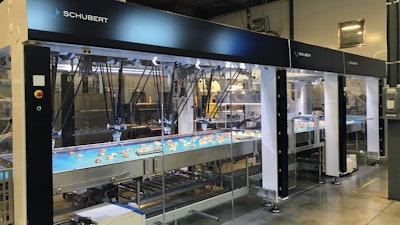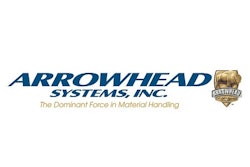Ideal for breakfast, on-the-go snacking, children’s lunches, or even large receptions, a diminutively sized pastry called a Micro Croissant® has been a big hit for baked product manufacturer La Petite Bretonne. In 2020, the 54-year-old, family-owned bakery in Blainville, Quebec will produce as many as 1.2 million Micro Croissants per day, in varieties like Danish and mini chocolate croissant. Some percentage of this high-volume product, alongside SKUs of cookies, madeleines, and more traditionally sized croissants, are sold under the La Petite Bretonne brand. But most of the croissants are produced for store brand, in-store retail, private-label, and foodservice applications throughout North America.
 Product is fed into the system (upper belt) in parallel to flow wrapped product exiting the Flomodul (lower belt), an example of what Schubert calls the counterflow principle.La Petite Bretonne is uniquely comfortable with this kind of volume. That’s because, since the inception of the business, founder and CEO Serge Bohec has pioneered pastry and croissant automation. Such products had been traditionally limited to small batches that were baked in artisan shops. But by automating over the years, the bakery is now capable of achieving that artisan quality at scale.
Product is fed into the system (upper belt) in parallel to flow wrapped product exiting the Flomodul (lower belt), an example of what Schubert calls the counterflow principle.La Petite Bretonne is uniquely comfortable with this kind of volume. That’s because, since the inception of the business, founder and CEO Serge Bohec has pioneered pastry and croissant automation. Such products had been traditionally limited to small batches that were baked in artisan shops. But by automating over the years, the bakery is now capable of achieving that artisan quality at scale.
In fact, Bohec and La Petite Bretonne were so ahead of the game with automation that they had to wait for consumers—particularly French Canadians with a discerning eye for pastry—to come around to the idea of croissants as a pre-packaged food on a shelf or in a carton. An initial rollout of a pain au chocolate [chocolate croissant] product in 2010 didn’t pan out since consumers just weren’t used to seeing croissants in a flow-wrapped package. But these days, after a decade’s worth of trends like on-the-go snacking, single-serving sizes, and convenience, the consuming public is ready for Danish and croissants made at an industrial scale.
“Consumers of these croissants want fresh products, but they also don’t want to have to rewrap the products at home for their kids’ or their own lunches. They want something that is easy,” says Audrey Laurin, CFO, La Petite Bretonne. “They are stressed, and often there are two working parents feeding themselves and their kids, so they do not have as much time as previous generations had. These individually wrapped products keep longer, as well.”
Scaling up
As the flow-wrapped chocolate croissants and Danish took off, Bohec recognized that sophisticated equipment was in order.
But any new pick-and-place and flow-wrapping system that Bohec might select would need to accommodate several different products on a single line, specifically Danish pastries and chocolate-filled croissants, both in two sizes. What’s more, these delicate, heat-sensitive products require exceptionally gentle handling. With those obstacles in mind, Bohec set about to automate.
He first got a look at the Schubert lightline Flowpacker at PACK EXPO International 2018 in Chicago. At that point, Bohec was already a bit of a Schubert connoisseur. La Petite Bretonne had collaborated with the machine builder for more than a decade, beginning when Bohec realized that the future would lie in “employing” robotics instead of humans for executing simple, repetitive tasks, such as picking and placing products on a conveyor. Ever since, Bohec had been strengthening his company’s supply chain process automation. When he was sizing up that lightline Flowpacker at PACK EXPO 2018, he already owned several Schubert machines at two manufacturing sites, both for end-of-line automation and for individual pick-and-place and flow-wrapping applications.
Sure enough, a year later at 2019’s PACK EXPO Las Vegas, it was a La Petite Bretonne-owned lightline Flowpacker machine that was on display at the Schubert booth—the Las Vegas show was just a brief pit stop between the factory and the SAT, installation, and commissioning in Quebec. Video of this machine as demonstrated at PACK EXPO Las Vegas can be found at pwgo.to/5509.
Equipped with a Flowmodul flow wrapper, four pick-and-place robots, and a 3D vision system for detection and inspection, the now-up-and-running system operates  The system currently employs four delta-style pick-and-place robotic arms, but can expand modularly in case of increased volume or speed.at La Petite Bretonne at speeds as fast as 280 product/min.
The system currently employs four delta-style pick-and-place robotic arms, but can expand modularly in case of increased volume or speed.at La Petite Bretonne at speeds as fast as 280 product/min.
Flexible, modular flow wrapping
An attractive component in the lightline Flowpacker system was Schubert’s new flow-wrapping component, the Flowmodul. According to the company, the Flowmodul can be seamlessly integrated into a pick-and-place line without interrupting the process flow. Equipped with Schubert’s latest robotic innovation—the flying cross-sealing unit combined with ultrasonic longitudinal sealing—the Flowmodul enables La Petite Bretonne to not only integrate several processes into a single system, but to also flexibly flow-wrap heat-sensitive products.
Schubert says the Flowmodul’s footprint is 70% smaller than single mechanical flow-wrapping lines, offering the bakery more space for future installations. The flow-wrapping process is fully integrated into the top-load machine (TLM) system and offers a slim, compact layout. Schubert’s T4 pick-and-place robots gently feed the Flowmodul’s infeed system within a tight space. Compared to infeed conveyors in conventional lines, this solution avoids product abrasion and breakage since it eliminates long infeed paths.
As mentioned previously, the Flowmodul is also equipped with new sealing technology for heat-sensitive products. The flow wrap’s longitudinal seam is sealed first using an ultrasonic sealing unit, followed by Schubert’s patented flying cross-sealing unit. The flying cross-sealing unit adapts to the upstream pick-and-place robots without damaging the product or the film. Via image recognition, the 3D vision system checks each product’s position, shape, volume, and orientation as well as color, and only allows flawless products to be processed.
“The sealing system means you don’t scrap the film or packaging materials,” Bohec says. “An imperfect product will never be placed onto the infeed chain, so we never waste materials on it, and the seals are perfect, so they never cause scrap. The machine also checks the packaging’s seal quality. When the roll of film is finished, another roll is swapped in automatically, without stopping. And film is expensive, so we avoid ever scrapping film.”
As the film is dispensed from the roll and travels to a die to wrap the product and eventually be sealed, a continuous ink-jet system codes each individual product with best-by dates or lot coding as needed.
The counterflow principle—smart and compact
The machine at La Petite Bretonne takes advantage of what Schubert calls the counterflow principle to efficiently produce flow-wrapped Danish and croissants. To apply this principle, a conveyor carries loose, random product into the enclosed frame of the machine’s first module. As it travels into this frame, it passes to the left of a parallel Flowmodul flow-wrapping station, all within the same frame. Product then travels into the frame of a second module, this one containing the 3D vision system for inspection and QC. Product then enters a third frame, where it is carried past the four camera-guided delta-style T4 robots. Here product is picked and placed onto a parallel infeed chain traveling 180 deg in the opposite direction, back toward the first machine frame and the Flowmodul the product had already passed. The product travels in a U-shape. Under the counterflow principle, raw product enters, and flow-wrapped product leaves the system from the same window in the machine enclosure.
Defective products, recognized in the second frame by the vision system, are never picked by the robots and end up discarded into a bin at the end of the infeed conveyor as it exits the third frame.
Speed up, slow down
As is the case with most baked products, a significant amount of cooling must occur prior to packaging, especially when the primary package is made from film. In this Danish line at La Petite Bretonne, product may travel 8,000 m during a 98-min travel through spiral conveyors. But thanks to the lightline Flowpacker’s flexibility, no accumulation is required.
Bohec explains, “With this machine, you don’t need to have someone keeping an eye on production speed because the machine automatically adapts to whatever the speed of production is. When it’s slow, the machine runs slow. When you have a lot of production, the machine goes fast automatically. It even stops automatically. And when you change the product, the robot changes the die in the flow wrapper.”
Limiting labor In the Flomodul, film rolls are swapped in automatically, without stopping. As the film is dispensed from the roll and travels to a die to wrap the product and eventually be sealed, a continuous ink-jet system codes each individual product with best-by dates or lot coding as needed.
In the Flomodul, film rolls are swapped in automatically, without stopping. As the film is dispensed from the roll and travels to a die to wrap the product and eventually be sealed, a continuous ink-jet system codes each individual product with best-by dates or lot coding as needed.
With its new system, La Petite Bretonne is able to limit the number of operators needed.
“For the speed, you would need six or eight people easily to keep up manually, and labor has been hard to find,” Bohec says.
Not coincidently, this satisfies a larger, company-wide directive to simultaneously improve employee morale and deal with an ever-shrinking workforce.
“One consideration that we also had choosing this equipment is that we are trying to reduce the number of employees working on back-breaking manual tasks,” Laurin says. “Instead, we want to have fewer employees with better jobs and better pay, doing something less difficult. Operating equipment is a lot of responsibility, but it is not as hard physically as packaging by hand, counting by hand, or executing repetitive movements that can cause injuries. This is something that we are very aware of when we buy a piece of equipment. Instead of lots of employees in harsh working conditions, we want a smaller roster of employees that, collectively, enjoy better working conditions.”
Format changeovers are fast thanks to the Flowmodul’s integrated, fully automatic conversion feature, which adapts to product length and different pitches. La Petite Bretonne packages 183 Danish/min, 220 chocolatine croissants/min, and 280 Mini-Chocolatines/min. “For a high-output production line, this is the best machine in the world,” Bohec says.
Downstream and secondary packaging
Currently, secondary packaging depends on the size of the product. For the larger Danish and croissants, it consists of a Meca-Pac tray erector sending glued trays by conveyor to a manned packout station corresponding with the Flowmodul’s outfeed conveyor. There, the trays are manually packed with product directly onto the conveyor on which the trays arrive. These larger packs are packed six by six, and then the trays enter a shrink-wrap machine and are sealed.
The smaller Danish and croissants are packed into a paperboard carton. The reason for the divergent packaging styles is that different SKUs are bound for different distribution facilities and channels, and ultimately, different kinds of customers. The larger Danish are usually sold in gas stations or convenience stores as single units, while the small Danish will be sold in six-count cartons in supermarkets.
At the time of our interview in January, the company wasn’t under contract to produce the smaller Danish product. But it will be producing the product for a private label in the spring, so Bohec is working on purchasing secondary packaging equipment to automate small Danish cartoning. The larger Danish secondary packaging process will likely be automated before long, as well.
“We actually have the secondary tray packaging machine from Schubert that we could use for the small Danish, but it’s in our cookie facility in Joliet City, Quebec,” Laurin says. “So while we have the complete system, they’re not working together at the moment. We expect to automate further to fill in the gaps and remove the manual labor in the near future.”
Both formats, either in cartons or trays, are then packed into corrugated shipper cases and palletized on a Robovic robotic end-of-line palletizer.  Equipped with Schubert’s latest robotic innovation—the flying cross-sealing unit combined with ultrasonic longitudinal sealing—the Flowmodul enables La Petite Bretonne to not only integrate several processes into a single system, but to also flexibly flow-wrap heat-sensitive products.
Equipped with Schubert’s latest robotic innovation—the flying cross-sealing unit combined with ultrasonic longitudinal sealing—the Flowmodul enables La Petite Bretonne to not only integrate several processes into a single system, but to also flexibly flow-wrap heat-sensitive products.
What’s next?
La Petite Bretonne purchased the lightline Flowpacker with the expectation of growing into it. The system’s modular nature and small footprint allow for even greater speeds if the bakery ever desired. For instance, two more delta robots in a small frame or module could be added, along with corresponding extensions of the conveyor entering the system and a parallel infeed chain feeding the flow wrapper. The Flowmodul as it exists could handle the increased speed and volume.
But that’s not to say the bakery didn’t hit the ground running already—in fact, the October 2019 installation was at the onset of the 2019 holiday season, La Petite Bretonne’s busiest time of year. Full production began immediately without much ramp-up, and it wasn’t long before the system was humming along at a 240-product/min cruising speed and topping out at 280 product/min.
But the frenetic pace of the holiday season prevented operators from undergoing full training on the machine, so the full potential has yet to be unlocked, for now.
“We were so busy that we did not have the luxury to send a few maintenance or operation managers to go to Charlotte [Schubert’s plant in North Carolina] to get better trained on the equipment,” Laurin says. “That will be done in the next few months. We’ll now have a chance to be trained and get the knowledge to better operate the machine. We’ll be able to put all the data that the machine can register for us to work to continuously improve, cut down on rejects, speed up changeovers, and be even more efficient.”
Visit pwgo.to/5509 to view a video of this system in action at PACK EXPO Las Vegas, just prior to delivery to La Petite Bretonne.

 Product is fed into the system (upper belt) in parallel to flow wrapped product exiting the Flomodul (lower belt), an example of what Schubert calls the counterflow principle.La Petite Bretonne is uniquely comfortable with this kind of volume. That’s because, since the inception of the business, founder and CEO Serge Bohec has pioneered pastry and croissant automation. Such products had been traditionally limited to small batches that were baked in artisan shops. But by automating over the years, the bakery is now capable of achieving that artisan quality at scale.
Product is fed into the system (upper belt) in parallel to flow wrapped product exiting the Flomodul (lower belt), an example of what Schubert calls the counterflow principle.La Petite Bretonne is uniquely comfortable with this kind of volume. That’s because, since the inception of the business, founder and CEO Serge Bohec has pioneered pastry and croissant automation. Such products had been traditionally limited to small batches that were baked in artisan shops. But by automating over the years, the bakery is now capable of achieving that artisan quality at scale.  The system currently employs four delta-style pick-and-place robotic arms, but can expand modularly in case of increased volume or speed.at La Petite Bretonne at speeds as fast as 280 product/min.
The system currently employs four delta-style pick-and-place robotic arms, but can expand modularly in case of increased volume or speed.at La Petite Bretonne at speeds as fast as 280 product/min.





























